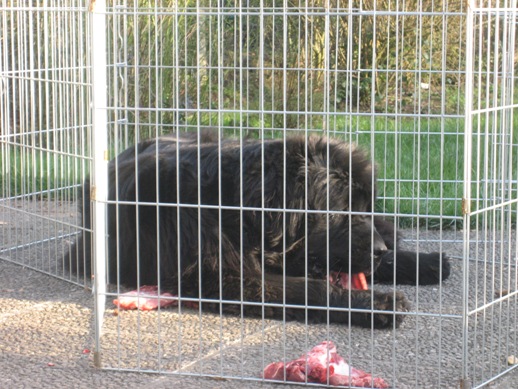Watercubs & Kivisilmän
working show-quality newfoundlands
and history
(feeding, vegetable mash,
feeding
tables)
Feeding B.A.R.F. food
BARF
comes from the words Bones and Raw Food (or Biologically Appropriate Raw
Food). The name says it all. The point is to feed the dogs as naturally as
possible, with raw food.
Remember to give everything RAW. The bone structure changes and will
splinter dangerously after heating!

With an adult dog it is not as necessary for the dog to get everything necessary in the daily diet as long as the montly diet is well balanced. However, feeding a growing newfoundland puppy, you have to be extra careful with what you give. The diet should be balanced weekly and should be changed in case of any abnormalities in growth patterns. READ: feeding tables
The best way to know if you are feeding correctly is to keep
an eye out for any changes and REACT accordingly to its consistency
of its feces.
For example if the feces are white and hard, there is too much bone in the
diet, and then the proportion of the “soft food” should be increased.
And vice versa; If the feces are too soft, you can add some more “hard
food”. The feeding plans may be changed according to what you can get
easily and for example seasonally.
The food can be divided into three categories:
1. ”Hard foods” consist of bones and meaty bones. The meat to bone ratio of the meaty bones should be roughly 50:50. The correct ratios can be found for example in pork ribs, rabbits, chicken thighs and turkey parts. During the winters it is usually a good idea to increase the fat content of the meaty bones by giving lard or meats that contain more fat.
The most important thing is to remember to keep the meat content in the meaty bones at at least 50%. If the bones have less meat, you can always add a chunk of meat to compensate the ratio.
Note: The feeding bones need to be “soft bones”. As a rough
rule of thumb you can feed anything you can get, except for the bones that
support heavy structures (for example cow thighs). The thigh bones can be
used as recreational activity, but not as a part of the main diet.
2. ”Soft foods”
are
all the organ meats,
fish and meats.
You should feed as many different things as you can find. Liver, kidneys,
heart, stomach and intestines are an important part of the diet. The
only thing to remember with these is that liver contains a lot of
non-soluable vitamin A, which is in large quantities harmful. Everything
else you can feed as much as you want to.
The stomach (Tripe) needs to be unwashed (i.e. green and very smelly). The
washed white tripe is not suitable, because all the useful vitamins have
been washed away). Tripe contains a lot of energy. Fish is probably one of
the best things you can give: it contains a lot of good oils and fats.
The more fish you can give, the better. Fish can also substitute some of
the meaty bones, because you should feed it whole (with the bones). Bacon is
not a suitable meat, because it has been salted.
3.
Vegetables.
Even
though this is only a small part of the diet, it is a very important one,
because this is where the dog gets all the necessary vitamins etc. The
vegetable mash can be regarded as a part of the being “soft” foods. The
fruit and vegetable glop must be frozen, because the dog cannot break
the plant cell walls. The freezing will damage the cells, so that the
vitamins can be utilized.
Making
the vegetable mash
Story: Making
70l in just one day
As a rule of thumb: 1/4 vegetable mash
1/4 soft foods
1/2 hard foods
After giving hard food; you have to give soft food so that the dog's stomach doen't get too hard. By observing the puppy or adult dog when they are hungry, you can develop a routine that works for you. FEED AND REACT!
It is difficult to estimate the exact amounts on how much food to give, but you will quickly see what works by observing your dog. An adult Newf eats 1-2% of its weight/day, but a puppy will eat much more. So, a female Newf weighing 50kg, will eat 500g-1kg/day.
You should not add supplements to the food.
The feeding method is the same for a puppy and an adult, the amount of food
just differs.
Feeding a puppy:
Follow your breeders advice. These instructions are only here to give you
some guidance.
A puppy will need a lot of food each day, so you have to feed it often. You can divide the food into 2-3 meals. It is a good idea to feed the puppy four times a day until it is four months old. For a seventh month old three times is ideal and a nine-month old should be fed twice a day.
An example of a feeding schedule:
Morning at 8:00 -
vegetable mash
Midday at 12:00 - meaty bones
Evening at 16:00 - meat
----
HINT: On hot days, you can give the food straight from the freezer: it cools
the dogs and the eating takes longer
Additional reading : http://www.rawmeatybones.com/book.php
(c) Salmelin